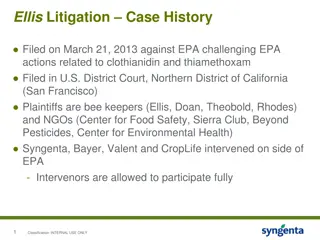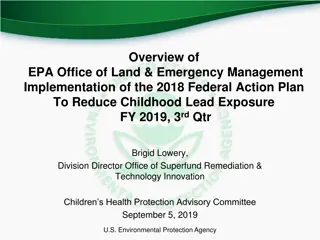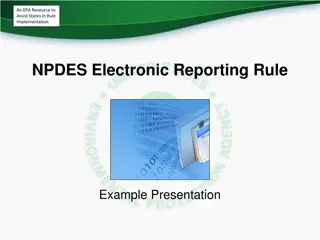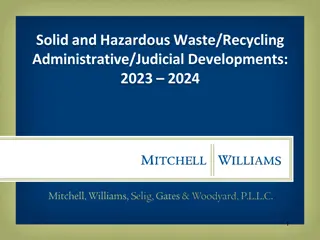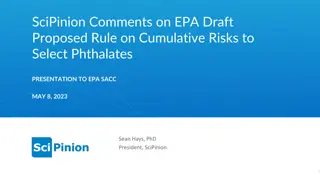Climate Justice & Disadvantaged Communities: Environmental Issues in US EPA Region 2
Climate justice and the impact on disadvantaged communities are key environmental issues addressed by Adriana Espinoza, Deputy Commissioner for Equity & Justice in US EPA Region 2. The initiative identifies and prioritizes disadvantaged communities based on multiple criteria, including environmental
5 views • 18 slides
Comprehensive Guide to End Point Assessment (EPA) for Apprenticeship
This detailed guide provides an overview of the End Point Assessment (EPA) process for apprenticeships, including timelines, requirements, and key steps such as project presentation, vocational competence discussion, and scenario evaluation. It covers aspects like completing the apprenticeship, Gate
4 views • 30 slides
Enhancing Synergies for a Resilient Tomorrow: EPA Regional Initiatives
The 3rd Joint Environment and Risk Management Platform, led by the US EPA Region 9, focuses on safeguarding environmental health in the US Affiliated Pacific Islands. The initiative aims to address deficiencies in water infrastructure, waste management, and hazardous waste sites. A new Circuit Rider
1 views • 6 slides
EPA's PFAS Strategic Roadmap: Commitments to Action 2021-2024
EPA's PFAS Strategic Roadmap, initiated by Administrator Michael Regan, outlines key actions from 2021-2024 to safeguard public health and the environment from Per- and Polyfluoroalkyl Substances (PFAS). It includes a comprehensive approach, timelines, and support for state efforts. PFAS are a group
5 views • 13 slides
EPA Cleaner Trucks Initiative Update
EPA is developing the Cleaner Trucks Initiative to tackle NOx emissions from new heavy-duty trucks. The ANPR was signed to gather feedback, with plans for NPRM in late Spring 2020. The program aims for nationwide emissions reductions through aligning with CARB, modernizing requirements, and enhancin
3 views • 6 slides
EPA Air Quality Monitoring System Overview
The EPA operates air quality monitoring stations across the United States, utilizing a cloud-based system with secure connections. Data from these stations, though lagging, covers various substrates like CO, Ozone, and Wind Speed. Users can access monitored parameters, set up the EPA API with a key
2 views • 11 slides
Understanding Regulatory Requirements for Pesticide Devices
Pesticide devices, as defined by FIFRA, play a crucial role in trapping, destroying, repelling, or mitigating pests or plant and animal life. While not required to be registered with the EPA, these devices are regulated under FIFRA sections 2(q)(1), 7, and 8, with specific labeling and packaging req
0 views • 10 slides
EPA's PFAS Action Plan and Drinking Water Activities Update
EPA's PFAS Action Plan, unveiled in February 2019, outlines a comprehensive approach to addressing PFAS challenges nationally. The Agency is committed to regulating PFOA and PFOS and proposes nationwide monitoring for PFAS in drinking water. Additionally, the Technical Support Center (TSC) is active
0 views • 10 slides
Technical Soundness of EU-SADC EPA Rules of Origin
The implementation and technical soundness of Rules of Origin under the EU-SADC EPA are crucial for the utilization of trade preferences. Compliance with rules of origin is essential for receiving tariff preferences, but drafting these rules accurately is challenging. Recommendations include specify
4 views • 12 slides
Resolving Data Quality Issues Prior to Transition at EPA
This content covers the process of resolving data quality issues before transitioning data at the U.S. Environmental Protection Agency (EPA). It includes information on different types of data quality checks, reviews, and corrections conducted by the EPA to ensure accurate and reliable data. The con
1 views • 9 slides
Litigation Case History Against EPA: Ellis v. EPA
Filed in 2013 by beekeepers and NGOs against EPA, the Ellis litigation case challenges EPA actions on clothianidin and thiamethoxam registrations. The case includes dismissed claims under APA and FIFRA, with a pending ruling on ESA violations. The litigation schedule involves ongoing Alternative Dis
0 views • 5 slides
Understanding NPDES Permit Application and Fees in Michigan
NPDES permits in Michigan regulate the discharge of municipal, industrial, and commercial wastewater, as well as stormwater, into state surface waters under Act 451. The permit fees vary based on the type of discharge, with separate fees for stormwater and non-stormwater discharges. Industrial storm
1 views • 13 slides
Eco-Remediation Goals Development Training Overview
This presentation by Mark Sprenger from the U.S. EPA discusses the development of Ecological Preliminary Remediation Goals (PRGs). It covers the process steps, assumptions, risk information activities, and resources related to ecological risk assessment within the EPA's programs. The training module
0 views • 53 slides
EPA Climate Change Update: Key Environmental Issues and Funding Overview
EPA Region 2 presented key environmental issues in the U.S. related to climate change and introduced the Inflation Reduction Act (IRA) with significant investments to reduce emissions. The act allocates funding across various sectors such as electricity, manufacturing, energy efficiency, and transpo
0 views • 28 slides
EPA Regulations and Clean Air Act: Legal Interpretation
The case of Util. Air Regulatory Grp. v. E.P.A. (2014) addresses whether the EPA's regulations on motor-vehicle greenhouse gas emissions trigger permitting requirements for stationary sources under the Clean Air Act. It delves into the provisions of the Act concerning both stationary and moving sour
0 views • 79 slides
Guidelines on EPA Region 9 Response Action Levels for TCE Contamination
EPA Region 9 has established response action levels for TCE contamination, with tiered concentrations for different exposure scenarios. The State of California provides guidance aligned with these levels. DTSC concurs with EPA's residential and industrial response levels but recommends consultation
0 views • 10 slides
EPA Office of Land & Emergency Management Overview on Lead Exposure Reduction
EPA's Office of Land & Emergency Management (OLEM) implements various programs to address lead contamination, focusing on reducing childhood lead exposure through cooperative efforts at federal, state, tribal, and local levels. OLEM supports an integrated approach to addressing multiple lead exposur
0 views • 9 slides
EPA Oil and Gas VOC Speciation Improvement Efforts
EPA's VOC Speciation transforms inventory species into Air Quality model species to support chemistry, ozone, and aerosol chemistry. The Speciate4.5 update in 2016 added oil and gas profiles, including location-specific uncontrolled profiles and WRAP profiles for various basins. The Uinta TMSR profi
2 views • 10 slides
The EPA: A Legacy of Environmental Protection since 1970
The Environmental Protection Agency (EPA) was established in 1970 following significant environmental disasters to protect human health and the environment. Before the EPA, pollution and toxic chemicals posed serious threats to air, water, and land, leading to sickness and death. The EPA's mission i
0 views • 13 slides
EPA Rule 40 CFR Part 63 Subpart HHHHHH Overview
EPA Rule 40 CFR Part 63 Subpart HHHHHH, also known as The Refinisher Rule, sets standards for hazardous air pollutants in paint stripping and surface coatings operations. The rule aims to control emissions of target hazardous air pollutants in collision centers and surrounding areas. It outlines req
0 views • 20 slides
Illinois EPA Environmental Justice Notifications Process Overview
Providing insights into the Illinois EPA's notification process for Environmental Justice concerns, including public participation policies, areas of concern, notification letters, distribution lists, and reasons for selective outreach. The process involves public engagement, GIS mapping tools, and
0 views • 17 slides
EPA Compliance Basics: Tank Leak Detection and Monitoring Methods
Learn about EPA requirements for tank leak detection, release detection methods, and compliance methods for monitoring tank systems. Understand the importance of implementing effective leak detection systems to prevent contamination and comply with federal regulations, including Automatic Tank Gaugi
0 views • 18 slides
Legal Battle Over EPA's Authority on Greenhouse Gas Regulation
The case of Massachusetts v. EPA revolves around a petition filed in 1999 requesting the EPA to regulate greenhouse gas emissions from new motor vehicles. Despite acknowledging its authority to regulate CO2 emissions, the EPA denied the petition in 2003, citing reasons related to the Clean Air Act.
0 views • 36 slides
Analysis of EPA's Authority to Regulate GHGs under the Clean Air Act
Massachusetts v. EPA (2007) addressed whether the Clean Air Act allows regulation of greenhouse gases (GHGs). EPA's findings on the rulemaking petition questioned its authority to regulate GHGs despite previous claims. The Act mandates EPA to issue regulations on air pollutants emitting from new mot
0 views • 32 slides
EPA Resource for NPDES Rule Implementation: Electronic Reporting
This EPA resource aims to facilitate the implementation of NPDES rules through electronic reporting, benefiting the environment and reducing reporting burdens. The initiative will transition the NPDES program into the digital age, enhancing efficiency, accuracy, and transparency while saving time an
0 views • 12 slides
European Parents Association - Empowering Parents in Education
The European Parents Association (EPA) was founded in Milan in 1985 and represents over 150 million European citizens through its member associations across Europe. EPA advocates for parents' rights in education and emphasizes the importance of parental involvement and support in their children's le
0 views • 14 slides
EPA Advance Notice of Proposed Rulemaking on Used Drum Management
The Environmental Protection Agency (EPA) has issued an Advance Notice of Proposed Rulemaking regarding the management of used industrial containers, specifically focusing on drum reconditioning. The ANPR seeks input on both non-regulatory and regulatory options to ensure the proper handling of cont
0 views • 66 slides
Enhancing Quality Assurance Practices in EPA Documents
This information session by EPA Quality Staff on February 13, 2013, focuses on proposing a Quality Standard for external organizations. It emphasizes the importance of quality assurance in decision-making processes and the benefits of documenting QA procedures. The session also introduces the concep
0 views • 20 slides
Ensuring Quality of TRI Data: EPA's Efforts and Guidelines
EPA plays a crucial role in ensuring the quality of Toxics Release Inventory (TRI) data through year-round efforts such as guidance, outreach, training, and assistance. Measures like using readily available information, making reasonable estimates, and following data flow and quality activities help
0 views • 25 slides
Understanding Soil Pollution and Contaminants: Impact, Regulations, and Remediation
Effects of Soil Pollution include harm to aquatic life, crop contamination, structural damage, and health risks. Various contaminants of concern, such as heavy metals and radioactive compounds, pose threats to the environment and human health. Regulations by the EPA and California EPA set screening
0 views • 32 slides
Proposal to Update New Mexico Water Quality Standards: Copper Site-Specific Water Quality Criteria for the Pajarito Plateau
Develop a proposal for the New Mexico Water Quality Control Commission to adopt EPA's 2007 recommended copper ambient water quality criteria, focusing on the history of U.S. EPA aquatic life criteria for copper, the use of the BLM tool in aquatic toxicology, and the overview of proposed site-specifi
0 views • 10 slides
Understanding PFAS Foam and EPA Regulations for Firefighting Applications
PFAS, components of firefighting foam, pose environmental and health risks due to their persistence. EPA regulations in April 2024 designated PFOA and PFOS as hazardous substances, enforcing controls on PFAS release. Thermal treatment offers a solution for PFAS disposal.
0 views • 6 slides
Update on Changes to EPA Emissions Inventory Tool
Updates to the EPA Emissions Inventory Tool include changes in table structures, documentation headers, and reporting requirements. The new Bridge Tool simplifies reporting processes and streamlines data categories for more efficient emissions reporting. Access the tool through the provided links fo
0 views • 33 slides
U.S. EPA's Proposed Cross-State Air Pollution Rule Update for 2008 Ozone NAAQS
The U.S. Environmental Protection Agency (EPA) issued the Cross-State Air Pollution Rule (CSAPR) in 2011, aiming to improve air quality by reducing power plant emissions across state lines. Challenges and subsequent revisions led to the proposed CSAPR Update Rule in 2015, targeting interstate air po
0 views • 27 slides
EPA's PFAS Action Plan: Addressing Potential Health Risks and Environmental Contamination
Per- and polyfluoroalkyl substances (PFAS) pose a significant environmental and health concern due to their widespread use and persistence. EPA's PFAS Action Plan, developed based on extensive feedback and comments, outlines a comprehensive approach to address these challenges. The plan focuses on r
0 views • 15 slides
Evaluation of Phthalates Cumulative Risks: Expert Insights
SciPinion presented findings and opinions on the EPA Draft Proposed Rule concerning cumulative risks associated with select phthalates. An expert panel, including former EPA scientists, shared perspectives on chemical grouping, the Phthalate Syndrome terminology, specific phthalates relevance, and t
1 views • 11 slides
The Impact of EPA on Ethanol Effect of BK Channel
Alcohol Use Disorders (AUDs) are a significant issue in society, with gene and environmental factors contributing to alcoholism. Ethanol, when consumed excessively, can severely impact physical and behavioral health by altering neurotransmitter levels. The presence of Eicosapentaenoic Acid (EPA), an
0 views • 15 slides
Understanding the EPA's Ozone Advance Program and Clean Air Act
The content covers key information about the EPA's Ozone Advance Program, including the basics of ozone, the Clean Air Act requirements, designation vs. classification, classification deadlines, and marginal classification requirements. It explains the formation of ozone, the importance of reducing
0 views • 40 slides
Important Information on Alabama EPA UST Regulations: Deadline and Testing Requirements
Alabama Tool Seminars are scheduled in various locations to discuss the new EPA UST regulations that came into effect in 2017. Owners of USTs storing specific biofuels must comply with compatibility requirements, conduct necessary testing by October 13, 2018, and ensure their systems meet the revise
0 views • 16 slides
Latest Updates on Wolverine EPA Activities
Explore the latest developments in Wolverine World Wide EPA updates, including personnel changes, PFAS listing, CERCLA PFAS rule updates, and progress at the House Street Disposal Area and Tannery sites. Get insights into upcoming actions like site inspections and rulemaking, shaping the environment
0 views • 14 slides










